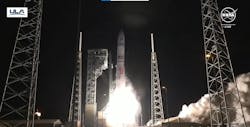Astrobotic commercial lunar lander experiences 'critical' propellant leak after launch
CAPE CANAVERAL SPACE FORCE STATION, Fla., - The Astrobotic commercial lunar mission - the world's first privately helmed Moon launch - successfully took off, but soon suffered a 'critical' leak of the propellant that threatens its ability to complete its mission.
Astrobotic's Peregrine launched in the early morning hours on 8 January 2024 from United Launch Alliance's Vulcan. The rocket successfully took off from Launch Complex 41 at Cape Canaveral Space Force Station in Florida. Hours into the planned 46-day journey to the Moon, Astrobotic in Pittsburgh noted that the Peregrine experienced an "anomaly."
"After successfully separating from United Launch Alliance’s Vulcan rocket, Astrobotic’s Peregrine lunar lander began receiving telemetry via the NASA [National Aeronautics and Space Administration] Deep Space Network. Astrobotic-built avionics systems, including the primary command and data handling unit, as well as the thermal, propulsion, and power controllers, all powered on and performed as expected. After successful propulsion systems activation, Peregrine entered a safe operational state. Unfortunately, an anomaly then occurred, which prevented Astrobotic from achieving a stable sun-pointing orientation. The team is responding in real-time as the situation unfolds and will be providing updates as more data is obtained and analyzed," the company informed on Monday.
A day later, Astrobotic explained that the Peregrine had been operational for approximately 32 hours, but the team had faced another spacecraft-pointing issue.
"The spacecraft started to tilt away from the Sun and reduced its solar power generation. The team was able to update the control algorithm and fix this issue. The batteries are at full charge," Astrobotic wrote in its seventh update following launch. "Given the propellant leak, there is, unfortunately, no chance of a soft landing on the Moon. However, we do still have enough propellant to continue to operate the vehicle as a spacecraft. The team has updated its estimates, and we currently expect to run out of propellant in about 40 hours from now — an improvement from last night’s estimate. The team continues to work to find ways to extend Peregrine’s operational life. We are in a stable operating mode and are working payload and spacecraft tests and checkouts. We continue receiving valuable data and proving spaceflight operations for components and software relating to our next lunar lander mission, Griffin.
The Peregrine lander's payload planned to facilitate the scientific exploration of lunar attributes, with a focus on the lunar exosphere, thermal characteristics of the lunar regolith, hydrogen concentrations in the soil at the landing site, and radiation environment monitoring.
The Peregrine spacecraft, which was launched as a part of NASA's Commercial Lunar Payload Services (CLPS), includes science and research payloads aimed to enhance the agency's comprehension of planetary processes and evolution, seek evidence of water and other resources, and contribute to the sustainability of long-term human exploration.
For this CLPS flight, NASA research includes:
- Laser Retroreflector Array: A collection of approximately half-inch (1.25 cm.) retro-reflectors – a mirror used for measuring distance – mounted to the lander. This mirror reflects laser light from other orbiting and landing spacecraft to precisely determine the lander’s position.
- Neutron Spectrometer System: This system will search for indicators of water near the lunar surface by detecting the presence of hydrogen-bearing materials at the landing site as well as determining bulk properties of the regolith there.
- Linear Energy Transfer Spectrometer: This radiation sensor will collect information about the lunar radiation environment and any solar events that might occur during the mission. The instrument relies on flight-proven hardware that flew in space on the Orion spacecraft’s inaugural uncrewed flight in 2014.
- Near InfraRed Volatiles Spectrometer System: This system will measure surface hydration and volatiles. It will also detect certain minerals using spectroscopy while mapping surface temperature and changes at the landing site.
- Peregrine Ion-Trap Mass Spectrometer: This instrument will study the thin layer of gases on the Moon’s surface, called the lunar exosphere, and any gases present after descent and landing and throughout the lunar day to understand the release and movement of volatiles. It was previously developed for ESA’s [European Space Agency] Rosetta mission.
